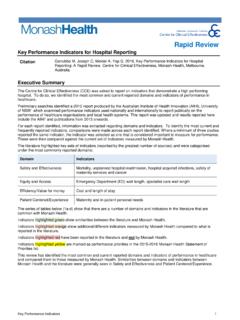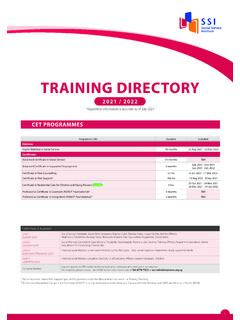Transcription of Nurse education models and frameworks - Monash Health
1 Nurse education models and frameworks : A Scoping Review 1 Nurse education models and frameworks Citation Yap G. & Melder A. 2018. Nurse education models and frameworks : A Scoping Review. Centre for Clinical Effectiveness, Monash Health , Melbourne, Australia. Executive Summary Background The Nursing and Midwifery education and Strategy is reviewing and revising their education framework to support organisational developments and uphold contemporary nursing and midwifery education planning and delivery across Monash Health . The Center for Clinical Effectiveness (CCE) was commissioned to undertake a literature review to inform the development of knowledge and understanding of education frameworks .
2 This includes contemporary planning and delivery of nursing and midwifery education models that may be used as a benchmark to support the development of a revised framework at Monash Health . Objective The literature review will aim to address the following sub-topics within Nurse education delivery models : 1) Site vs ward based delivery; 2) Informal vs formal education ; 3) Evaluation of education programs; 4) Benchmarking of professional education models . Search Strategy Two medical databases and four other internet sources were searched using key words related to Nurse education and models . Details and results of the search are included in Appendix 1 Table 5 and 6. Papers identified were screened using inclusion and exclusion criteria established a priori.
3 Results Five items of peer-reviewed literature and one item of grey literature was selected for inclusion in the review. Peer-reviewed evidence included in this review was limited to a few descriptive studies subject to high risk of bias, and articles written on the topic of Nurse education . Most of the models were proposed or newly designed, only two models were evaluated for its effectiveness. Summary of Findings 1. Nurse education models used across Australia (Site and ward based delivery) The literature describes models of education that are centralised, decentralised or a combination of the two. Site and ward-based education delivery appears to be consistent with a decentralised model of Nurse education .
4 In a recent study a centralised Nurse education service model reported to have more responsibilities and functions within an organisation than other service models , that is, decentralised or combination models [1] In comparing the three models , Nurse educators from a centralised Nurse education service model agreed the most common functions included: 1. Supports formal training programs 2. Coordinates the graduate Nurse program 3. Coordinates student Nurse placements 4. Supports service redesign 5. Mentors staff undertaking new roles Scoping Review Nurse education models and frameworks : A Scoping Review 2 A centralised model has a number of advantages over a combination or decentralised model [1].
5 These advantages are depicted in the figure: 2. Learning models in nursing education (Informal and formal education ) A number of models have been summarised to look at how learning, teaching and assessment can be integrated to benefit the learner and the benefits this may have in nursing education and continuing professional development courses. [4] These domains refer to specific element of skill acquisition, knowledge creation or value and attitude development that happens during formal and informal learning. Furthermore, learning in nursing was divided into three distinct domains; Cognitive domain refers to the theoretical knowledge underpinning clinical practice, contextualising and consolidating existing theoretical knowledge is used in the context of working as a mentor in clinical practice.
6 Figure 9 explains the components of the Cognitive domain. Psychomotor domain increase in skill base where an aspect of practice becomes second nature and no conscious effort is required. This includes, situated learning, work-based or experiential learning, and social learning. This also reflects what is also known as the 70-20-10 model (described further in a separate report). Figure 10 explains the components of the Psychomotor domain. Affective domain places emphasis on values. The affective learning domain learning theory has been implemented as a means of considering how students can relate to values and beliefs in Health care. ( , in the context of breaking bad news to family members, which happens through reflective processes).
7 This domain encompasses actions described in Figure 11 [4] Empowering education model in nursing Empowering education is a model devised for in-service training of nurses that can desirably match the training programs with learning needs for the nursing staff. The new empowering education model composes of self-directed learning and practical learning. Owing to its practical nature, the empowering education model can facilitate occupational tasks and achieving greater mastery of professional skills among the nurses [2] Nurse education models and frameworks : A Scoping Review 3 3. Evaluation of education programs Kirkpatrick model of evaluation [5] Since Kirkpatrick first published his evaluation model , many continuing nursing education providers have used it.
8 [5] The Kirkpatrick model of evaluation includes four levels for evaluation: (a) reaction, (b) learning, (c) behavior, and (d) results. Levels of evaluation were built in a step-wise fashion. The value of the evaluation methods have been discussed in the context of continuing nursing education . Four levels of evaluation in the revised Kirkpatrick model of evaluation (2016) [5] 4. Benchmarking Department of Health (Queensland) [6] The registered Nurse professional practice in Queensland use the Benner s practice pathway Benner (1984) proposed that nursing knowledge develops through research and integration into clinical practice and experience. Importantly, experience is not a time based activity, but can only develop in the context of education and knowledge acquisition.
9 Characteristics acquired throughout the registered Nurse professional career contribute towards a sustainable profession through: Role modelling Clinical leadership mentoring and coaching Supervision Teaching Research Banner Health Professional Practice model [3] Professional practice models (PPMs) are an integral part of any organisation on the Magnet journey, whether initial designation or redesignation. Through the journey, the PPM should become embedded within the nursing culture. Banner Health embeds the Professional Practice model (PPM) into all areas of nursing practice to support and elevate nursing practice and patient care. Strategies to support a high level of embeddedness of the PPM include: Integration into position descriptions New employee orientation for nurses (clinical and leaders) Support for the evidence-based practice (EBP) model Nursing awards and recognition programs, A structure for the clinical ladder and leadership models at the department/facility and system level, Nursing peer review (NPR) Documentation supporting Magnet designation and resignation Conclusions There is limited peer-reviewed literature comparing the effectiveness of Nurse education models and approaches.
10 Subsequently, this makes it difficult to draw conclusions on the most effective models or approach. There was a paucity of evidence offering insight to informal vs formal or site vs ward-based approaches; however, results from a qualitative study of mixed methods suggest that a centralised service model is advantageous over a decentralised or combination model in the Australian context, and it is suggested that healthcare organisations adopt a centralised model . [1] An empowering education model can also facilitate occupational tasks and achieving greater mastery of professional skills among the nurses. [2] Level 1 (Reaction): The data equate to customer satisfaction and confirm the quality of the activity and the satisfaction with the instructor.




